What if your WINGS had the Speed of a Cheetah and the Agility of a Gazelle? Would you put a Honey Badger in as SCRUM HALF? Can your PROPS push 850 times their own weight like a Hercules Beetle?
Originally made in response to this a Japanese Video, Watch this whimsical video on what a Rugby Team would look like if you recruited in the zoo.
Below you’ll find a slightly more serious description of how all sizes, shapes and temperaments make up any Boys or Girls Youth Rugby Team.
Rugby Positions
It is often said that Rugby is the most inclusive of all team sports with a position that fits the abilities of every body type. Massive Front Row Props and Centers with extraordinary balance, stamina with powerful legs and backs to lithe and nimble wings that dart into the the play with incredible speed and dexterity.
The Forwards Line up in a Scrum
Lock lifted to receive ball in Lineout
Pressure inwards and Forward
The Forwards: In fifteens rugby the forwards make up numbers 1 through 8. This the power and muscle of the rugby team. The forwards do the brunt of the tackling, rucking and hitting that goes on for the 80 minutes of a match. During a scrum, the pushing huddle like contest used to restart play after a penalty, the forwards are aligned into 3 rows.
The Front Row consists of two Props, numbers 1 & 3 flanking a Hooker, number 2. During the scrum the props bind tightly to the hooker and to the opposing props opposite. When the scrum half feeds the ball into the scrum the props create the stability that allows the hooker to get a square strike at the ball to send it to the back of the scrum towards the 8 man. During a lineout, which is used to restart play after a ball goes out of bounds, it is the hooker that throws the ball into contest with a swift double overhand throw. The props are in the line ready to support the jumpers, often locks, who are lifted above the fray so the ball remain out of reach of most of the opposing players.
The Second Row are the Locks, numbers 4 and 5. Usually the tallest on the team the locks are often lifted by the props in the lineout. In the scrum they help with the push forward and assist the binding of the props to the hooker with a long, low body position to maximize the strength of the scrum. Locks carry the ball often into contact and tackle opposing ball carriers.
Immediately behind and outside of the Locks are your two Flankers.
Hooker Throwing in at Lineout
Usually more muscular but shorter than the Locks, The Flankers, numbers 6 and 7, lead the team in tackles, especially in a defensive scrum. or on a blitz. Sometimes used a receivers in the lineout and very aggressive, athletic ball carriers in open play.
Calm, Cool under pressure and usually the biggest player on the field, the 8 Man, wearing the number 8, steers the scrum the center back. Multitalented and versatile, the number 8 takes control when the ball reaches the back of the scrum. You will see the 8 man distributing the ball, carrying the ball, clearing out rucks and s an alternate receiver in the lineout.
The Rugby Backline
Scrum Half Passing from Scrum
The rest of the Rugby Team in 15s is the Back Line. Speed, agility, with fancy footwork, terrific acceleration and almost magical ball handling make the numbers 9 - 15 the excitement on the rugby pitch.
Number 9, the Scrum Half, usually the smallest guy or gal or any rugby team with the largest personality, they feed the ball into the scrum to restart play, distribute that same ball from the feet of the 8 man and during a lineout it is often the scrum half that receives the ball from the lifted lock. During open play they use a superior game sense to feel out the play and position themselves as the most involved player out there.
Kicking Duties usually fall to the Fly Half, or number 10. The Fly Half acts as the quarterback that directs the attack and often receives the ball from the scrum half if it isn’t sent directly a forward. Larger than a scrum half, the Fly Half is known for delivering precise kicks, converting trys and taking the penalty kicks for points or into touch for territory.
The Centers, numbers 12 and 13, like a football running back the inside and outside center are skilled ball carriers that are strong and tough enough to endure all of the collisions and tackles that the positions lends itself. Centers make good good alternative first receivers if the Fly Half is otherwise engaged or out of position.
Wings, wearing the numbers 11 or 14, come in the greatest variation in size and body type. Some are fleet of foot with fancy footwork that will leave a prop with his legs tied, others are like a speeding semi truck, unstoppable with momentum.
Number 15, the Fullback is set back in the deepest, further back side of the pitch. Similar in size to the Fly Half but usually faster that can kick back a ball for territory during open play forms the last line of defense against break in the line.








